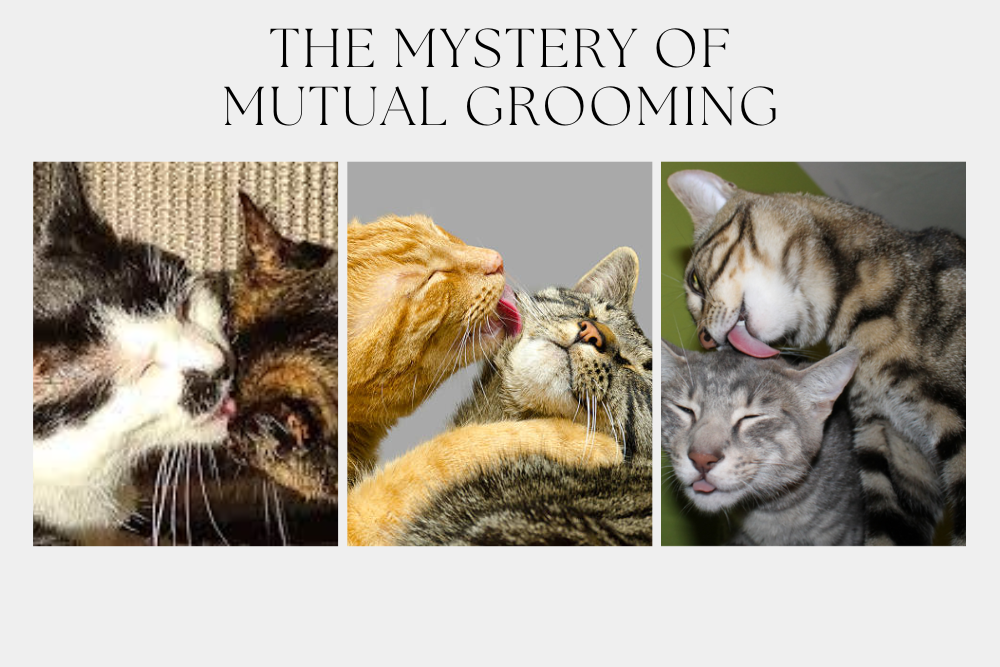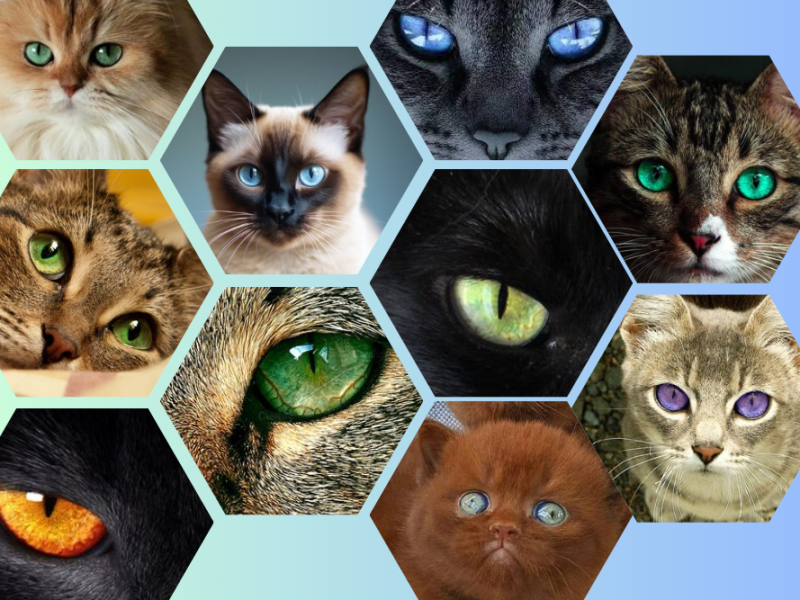In the enchanting realm of feline behavior, the act of mutual grooming stands as a captivating tapestry woven with both biological and psychological threads. “Cats Groom Each Other” isn’t merely a statement; it’s an exploration into the depths of a mysterious feline world where grooming goes beyond mere cleanliness. From the nuances of hygiene and heat regulation to the intricate language of social bonding, this article delves into the reasons behind why cats engage in this behavior.
Join us as we navigate through the silent conversations, dominance displays, and the nurturing gestures that make up the fascinating phenomenon of cats grooming each other. Beyond the surface-level understanding, we’ll explore the physical and mental health benefits, exceptions and anomalies, and provide insights into preventing potential issues such as over-grooming. Embark on a journey to comprehend the nuances of “Cats Groom Each Other” and gain a holistic understanding of the complexities that define feline social dynamics.
The Mystery of Mutual Grooming
Biological Reasons for Cats Grooming Each Other
One primary biological motive behind cats grooming each other is hygiene. In the feline realm, cleanliness is not just a virtue but a crucial aspect of survival. Cats meticulously groom their fur to remove dirt, parasites, and unwanted odors, ensuring they remain stealthy and adept hunters. Transporting cats across the country requires much more safety precautions.
Heat Regulation: The Feline Thermostat
Beyond cleanliness, mutual grooming plays a role in heat regulation. Cats lack sweat glands, and their meticulous grooming helps them stay cool by distributing saliva on their fur, enhancing the cooling effect when they groom each other.
Social Bonding: A Cat’s Silent Language
Grooming is a form of non-verbal communication among cats, a silent language expressing camaraderie and social bonds. This ritual reinforces connections, building trust within the feline community. It’s a way for cats to say, “You’re part of my social circle, and I acknowledge our bond.”
Dominance Display: Grooming as a Power Play
In the complex world of cat hierarchies, grooming can be an assertion of dominance. The cat being groomed may be acknowledging the other’s superiority, establishing a clear pecking order within the group.
Psychological Reasons of Why Cats Groom Each Other
Bonding: Strengthening the Feline Family
The act of grooming fosters bonding, especially among cats that share close relationships. Whether between siblings, mother and kittens, or companions, mutual grooming reinforces emotional ties and builds a sense of security within the feline family.
Motherly Love: Nurturing Through Grooming
For mother cats and their kittens, grooming is a nurturing activity. It not only keeps the kittens clean but also provides comfort and strengthens the maternal bond. Mother cats groom their offspring as a way of expressing love and care, creating a foundation for a healthy mother-kitten relationship.
Acceptance: Feline Social Integration
Grooming is a social cue signifying acceptance within the feline group. Cats groom each other to demonstrate inclusion and acknowledgment, creating a harmonious social structure. It’s a way for cats to say, “You’re part of our community, and we accept you.”
Cleaning Assistance: Teamwork in Feline Hygiene
In multi-cat households, mutual grooming serves as a collective effort to maintain hygiene. Cats engage in reciprocal grooming, ensuring each member of the group stays clean and healthy. This teamwork reinforces the social fabric within the group, creating a cooperative environment.
It’s Very Normal for Cats Groom Each Other
Benefits of Mutual Grooming
Physical Health: A Cat’s Well-being
Mutual grooming contributes to the physical well-being of cats. It aids in the removal of loose fur, preventing hairballs, and promotes a healthy coat. Additionally, the act of grooming stimulates blood circulation, maintaining optimal skin health.
Mental Health: Cat Wellness Beyond the Physical
Beyond the physical benefits, mutual grooming has a positive impact on the mental health of cats. It reduces stress and anxiety, providing a soothing and comforting experience that contributes to overall feline well-being.
Inter-cat Relationships: Strengthening Social Ties
Mutual grooming is a cornerstone of positive inter-cat relationships. It establishes a sense of community and cooperation, fostering a peaceful coexistence among feline companions. Strong social ties among cats contribute to a harmonious living environment and reduce the likelihood of conflicts.
Exceptions and Anomalies
Dominance Display: Grooming as a Power Play
While grooming is often a sign of harmony, it can also serve as a display of dominance. Cats may engage in grooming to assert their authority within the group, signaling their position in the feline hierarchy. Understanding the dynamics of dominance grooming is crucial for cat owners to maintain a balanced and peaceful multi-cat household.
Over-Grooming: When Too Much is Too Much
What is Over-Grooming?
Over-grooming occurs when a cat excessively licks or chews its fur, leading to potential health issues. Identifying and addressing over-grooming is crucial for the well-being of your feline friend.
Identifying Over-Grooming in Cats
Spotting over-grooming is relatively straightforward. Keep an eye out for bald spots, redness, sores, or changes in your cat’s coat texture. Persistent licking or chewing in a specific area could be a clear indicator of over-grooming.
Causes of Over-Grooming
Understanding the root causes of over-grooming is essential. It can be triggered by stress, medical issues, or environmental factors, requiring a comprehensive approach to address the underlying issues.
Steps to Stop Your Cat from Over-Grooming
Modify Your Cat’s Environment
Creating a stress-free environment is crucial in preventing over-grooming. Ensure your cat has a comfortable and enriching space, minimizing potential triggers that may lead to excessive grooming.
Preventing Over-Grooming in the Future
Regular veterinary check-ups, a balanced diet, and addressing any underlying medical issues are key to preventing over-grooming. Proactive measures contribute to maintaining your cat’s physical and mental well-being.
Further Insights into Feline Grooming Behavior
Cultural Significance: Regional Variations in Grooming
Interestingly, the act of grooming among cats can have cultural significance, with regional variations in grooming behavior. Some cat communities may place higher importance on grooming rituals, while others may exhibit different patterns based on their environmental and social factors.
Evolutionary Perspectives: Grooming in the Wild
Examining feline grooming behavior from an evolutionary perspective reveals insights into how this ritual developed in the wild. Understanding the ancestral roots of grooming provides context for its prevalence in domesticated cats today.
Grooming and Communication: Decoding Feline Body Language
In addition to mutual grooming, cats use various body language cues to communicate with each other. Understanding these subtle signals enhances the comprehension of feline social dynamics and strengthens the bond between cats and their human companions.
Your Questions Answered Regarding Cats Groom Each Other
Why do cats groom each other?
Cats groom each other for a variety of reasons, including hygiene, heat regulation, and social bonding. It’s a natural behavior that serves both biological and psychological functions, contributing to the overall well-being of the feline community.
Is mutual grooming common among all cat breeds?
Yes, mutual grooming is a common behavior observed across various cat breeds. While the frequency and intensity may vary, the act of grooming is a universal aspect of feline behavior that transcends breed differences.
What role does grooming play in the hierarchy of cat groups?
Grooming can serve as a form of dominance display within cat groups. The act of one cat grooming another may signify a hierarchical structure, with the groomed cat acknowledging the grooming cat’s authority.
How can I encourage positive grooming behavior among my cats?
To encourage positive grooming behavior, create a stress-free environment, provide enriching experiences, and ensure each cat has its personal space. Positive reinforcement, such as treats or affection, can also foster a healthy grooming dynamic among cats.
Are there any health benefits associated with mutual grooming?
Yes, mutual grooming offers several health benefits. It aids in the removal of loose fur, preventing hairballs. Additionally, the act of grooming stimulates blood circulation, promoting optimal skin health and contributing to the overall physical well-being of the cats involved.
What should I do if I notice over-grooming in my cat?
If you notice over-grooming in your cat, it’s crucial to identify the underlying cause. Look for bald spots, redness, sores, or changes in coat texture. Consult with a veterinarian to rule out any medical issues and consider modifying the cat’s environment to reduce stressors.
Can over-grooming be a sign of a more significant health concern?
Yes, over-grooming can be a sign of underlying health concerns, including allergies, skin conditions, or psychological stress. Regular veterinary check-ups are essential to address any potential health issues contributing to over-grooming.
Are there cultural variations in grooming behavior among cats?
Yes, grooming behavior can have cultural significance among cat communities. Regional variations may exist, influenced by environmental and social factors. Some communities may prioritize grooming rituals differently than others.
Can I use grooming as a way to introduce new cats to each other?
Yes, introducing cats through grooming can be an effective way to establish positive relationships. Supervise the initial interactions and provide a calm environment to ensure a smooth introduction through mutual grooming.
How can I differentiate between normal grooming and over-grooming?
Normal grooming involves maintaining a clean coat, while over-grooming is excessive and can lead to health issues. Look for signs such as bald spots, redness, sores, or changes in coat texture. If you notice persistent licking or chewing in a specific area, it may indicate over-grooming.
Why Do Cats Bite Themselves While Grooming?
Cats biting themselves during grooming may be attributed to various factors. One common reason is the presence of mats or tangles in their fur, causing discomfort. Additionally, skin irritations, allergies, or the discovery of a painful spot may prompt a cat to bite itself. Behavioral issues, stress, or anxiety could also manifest as self-biting during grooming, highlighting the importance of observing the context and seeking professional advice if needed.
How Much Time Do Cats Spend Grooming?
The amount of time cats dedicate to grooming varies among individuals and breeds. On average, cats spend 30% to 50% of their waking hours grooming. Factors influencing grooming duration include age, health, and environmental stressors. While grooming is a natural behavior, excessive or reduced grooming may indicate underlying issues, warranting attention from pet owners.
Why Do Cats Stop Grooming?
Cats may stop grooming themselves for several reasons. Health concerns, such as arthritis or dental issues, can make grooming uncomfortable. Behavioral changes, stress, or depression may also lead to a decrease in grooming. Additionally, obesity or other medical conditions affecting mobility can impact a cat’s ability to groom effectively. Identifying the root cause is crucial to addressing any potential health or well-being issues.
Why Do Older Cats Stop Grooming Themselves?
As cats age, they may experience a decline in grooming habits. Arthritis or reduced flexibility can make self-grooming challenging for older cats. Dental issues, vision problems, or other health issues associated with aging may also contribute to a decline in grooming. In such cases, pet owners should provide assistance by gently brushing their cat’s coat and addressing any underlying health concerns through veterinary care.
When Cats Stop Grooming
Cats may stop grooming for various reasons, and the timeline can vary. Sudden cessation of grooming could indicate an acute health issue, while a gradual decline may be associated with aging or chronic conditions. Changes in grooming behavior should prompt a thorough examination by a veterinarian to rule out potential medical concerns. Monitoring grooming habits is essential for proactive pet care, ensuring the overall well-being of our feline companions.
Final Thoughts on Cats Groom Each Other
While mutual grooming is a natural and beneficial behavior among cats, it’s essential for cat owners to delve deeper into the intricacies of feline grooming behavior. Exploring the biological, psychological, and cultural aspects provides a comprehensive understanding, enabling cat owners to foster a nurturing environment that promotes the well-being of their feline companions. By embracing the complexities of feline grooming, cat owners can strengthen their connection with their pets and ensure a harmonious coexistence in the shared space they call home.


